Abstract
The heatwaves that have affected our civilization in recent years pose a serious threat to the environment as well as the proper functioning of our bodies. Schools are facilities with specific microclimatic requirements. Thermal conditions in educational buildings are decisive for the stimulation and efficiency of the learning process, as well as the interaction of students. Based on the measurements of thermal comfort carried out in the school building, with the energy standard of a passive building, it can be observed that in schools with very low energy consumption, the problem of interior overheating may occur in the summer months. In this paper, an attempt was made to search for alternative passive measures allowing for the required indoor microclimate conditions to be obtained. Such solutions are in line with the spirit of the European energy policy and sustainable development. A model of the school under study was created using the Design Builder simulation program. The role of mechanical ventilation and the possibility of night ventilation in reducing discomfort were examined. Consideration was given to the justification of using expensive heat pump installations with a ground heat exchanger to reduce overheating in summer. The application of the adaptive approach to the assessment of thermal conditions and the acceptance of limited overheating periods led to the conclusion that the analyzed building could function successfully without these additional installation elements. A proprietary tool for the analysis of microclimate conditions was proposed to estimate the hours of discomfort in a way that is objective and easy to calculate.
1. Introduction
The rising climate change is a serious humanitarian and ecological threat today. The noticeable increase in temperature has a negative effect on the surrounding environment. Solutions are being sought to enable the design and use of energy-efficient buildings while ensuring the comfort of users [1]. The terms energy-efficient or low-energy buildings do not involve any objective technical specification of building envelope characteristics or energy demand. It is usually related to local conditions and understood as a standard far ahead of the current requirements. Likewise, requirements of the European directive 2010/31/EU for a “nearly zero-energy building” are generally defined as “very high energy performance” and are understood and interpreted differently in each member state according to local circumstances and regulations. On the other hand, the passive building standard introduced in Germany was based on a list of precise technical requirements. One of the most specific and well-known requirements on this list is the reduction of the energy demand for heating to the value of 15 kWh/(m2·year) [1]. For passive houses, specific overheating requirements can also be found. It is required to ensure thermal comfort in winter and summer, with the limit of 10% of year above 25 °C. In the case of the EU directive, attention was drawn to the relationship between the mechanical cooling of buildings during summer and the peak demand for electricity. Hence, there is a strong recommendation to use all available passive measures to protect the building against overheating. These measures include shading of glazed parts or the use of the accumulation properties of buildings. One of these passive measures is also the night cooling of the interior, which was more widely analyzed by the authors of this paper.
The appropriate quality of the internal environment in schools is particularly challenging for the modern world. Low-energy educational facilities with specific microclimatic requirements and a characteristic manner of operation must, above all, provide safe and comfortable conditions for young people. What is extremely desirable in winter (good insulation, large glazing on the south side, high airtightness) can be a big problem in summer. Passive buildings and nearly zero-energy buildings should meet the requirements for thermal comfort throughout the expected period of climate warming.
The issue of thermal comfort in buildings with very low energy consumption is the subject of many studies and analyses. In numerous international and national publications [1,2,3,4,5,6,7], the problem of discomfort during the summer months has often been discussed. According to Dudzińska [1], it is important to rationally use window shading to ensure a favorable microclimate inside. The author compared the conditions of the internal environment in a passive sports hall without shading and taking into account shading blinds and sun breakers. The conducted analysis showed that due to the combined use of external blinds and sun-breakers, the solar gains were reduced by half. It should be noted that in this case significantly more energy was needed to illuminate the hall, which was also associated with the generation of additional heat gains. However, it was shown that well-designed sun-breakers and external shutters efficiently reduced space overheating. Jones et al. [2] pointed out that overheating of the interior is an unintended consequence of the drive in recent decades to reduce energy consumption in space heating. In their article, they monitored temperatures in identical houses in the south-west of the UK that were built to low energy standards. Based on the analyses, it was found that the buildings were exposed to overheating in summer; however, the residents played an important role in reducing or increasing the internal temperature (opening windows, lowering roller shutters, controlling airflow). Article [3] assesses the thermal comfort in zero-energy buildings in Great Britain. The results indicate that increasing the thermal mass of external walls significantly reduces the risk of overheating, as does night ventilation. Additional sun protection on the southern, eastern, and western elevations significantly improved the conditions of thermal comfort. According to Kisilewicz [4], the one-sided minimization of heat losses and maximization of solar gains in a low-energy building in winter often result in an intense overheating of the interior in summer and transition periods. He pointed out that increasing the proportion of renewable energy in the heat balance of a building is partially possible due to the rational use of solar energy. However, in practice, the emphasis on low energy demand for heating often causes intensive overheating of the interior in summer or requires cooling. Kisilewicz conducted an analysis of energy consumption in a low-energy building in relation to the size of the window. The analyses showed that large glazing, which is currently fashionable, may lead to excessively high internal temperatures (over 27 °C) of over 70% in the summer-time. That is why it is so important in the design process to pay attention to the passive measures of protection against overheating in the form of shading devices and night ventilation, combined with the high thermal inertia of the building structure. Bzowska [5,6] showed that energy-efficient buildings equipped with a natural ventilation system, with insufficiently high thermal mass, often overheat in summer. In the 21st century, an average temperature increase of 4.0 °C is estimated; therefore, one of the most important factors of building design is ensuring an adequate level of thermal comfort in new and modernized buildings. Passive facilities and nearly zero-energy buildings must meet the requirements for thermal comfort not only now, but also in the future, throughout the period of the projected climate warming. Scientists Fedorczak–Cisak et al. [7] pointed out that the current architectural trend, considering the use of glass facades on the south side, is defective due to the high costs of sun protection and cooling systems, and the lack of the required level of thermal comfort. The research was carried out in the experimental building of the Małopolska Laboratory of Energy-Saving Construction (MLBE), in which a variety of highly efficient heating, cooling, and ventilation devices were used, run by an integrated control system. The facility has 14 independently metered thermal zones, where it is possible to change quintessential parameters such as temperature, humidity, and airflow. This study [7] presented selected results of tests carried out in two sample rooms, one of which was designed in accordance with the requirements of low-energy buildings, and the other with the use of typical solutions commonly used in Poland. The tests carried out confirmed significant energy savings and greater stability of thermal conditions in the shaping of thermal comfort in energy-saving facilities. During critical hours (2:00–3:00 p.m.), 100% of people present in a typical room felt discomfort, while in the test room the number of people experiencing discomfort did not exceed 10%. The authors confirmed that while appropriate shading elements can reduce the costs of cooling the building, they do not ensure thermal comfort.
Overheating of the interior is associated with significant difficulties, costs, and dangers for the users of the facilities, and as a result causes a negative social attitude towards these solutions. Simple architectural and construction solutions are being sought, which are viable and rationalize the use of energy and reduce discomfort in the summer. Ground heat exchangers, recommended in low-energy public utility construction, generate both additional investment and operating costs; therefore, investors still approach such a solution with skepticism. The simplest and cheapest way to protect the building from overheating is to rationally ventilate the building at night in summer. This removes the accumulated energy in well-insulated buildings and reduces the internal temperature. The energy costs for cooling are minimized through night ventilation, and the reduced temperature of the roomy spaces may help in achieving thermal comfort during the next hot day [8,9,10,11,12]. The effectiveness of natural night ventilation depends on the local climatic parameters (indoor–outdoor temperature difference, average range of outdoor temperature, wind speed and direction), and building parameters (thermal inertia of the building and convective heat transfer between the ventilation air and thermal mass), as well as technical parameters of the ventilation system (night ventilation intensity and control strategy) [13,14,15]. A number of studies and analyses have been carried out around the world regarding the influence of night ventilation on shaping thermal comfort in a building during summer.
In 1999, in a low-energy office building in Great Britain with night ventilation with a gravity flow of 10 h−1, Kolokotroni and Aronis achieved a 30% reduction in energy consumption for cooling and a 40% reduction in installed cooling capacity [9,12,16]. In 2004, in Belgium, Gratia et al. [17] achieved a 40% reduction in the daily cooling demand in a narrow office building with high mass, using natural night ventilation. On the other hand, in 1997, Blondeau et al. [18], based on the comfort measurements in the building of the University of La Rochelle, found that the Predicted Mean Vote (PMV) value decreased from 1.5 (warm) to 0.75 (slightly warm) when using mechanical night ventilation [19].
Dealing with the issues of the efficiency of night ventilation, Artmann et al. [20,21] concluded that climatic conditions and the airflow rate had the greatest impact on this form of cooling. According to Kolokotroni [22], the most favorable climate for the application of natural night ventilation is a moderate climate with large fluctuations in daily temperatures in the summer. In countries such as Switzerland, Germany, or Great Britain, with relatively low night temperatures, even in summer, passive cooling of buildings seems to be a fruitful technique in shaping thermal comfort [20]. The recommended minimum difference in diurnal temperatures in natural night ventilation is about 10–12 K [23,24]. A significant reduction in the cooling potential is observed in dense urban environments as a result of a dramatic fall in wind speed [25,26].
One of the buildings where research and simulation analyses of thermal comfort were carried out is the energy-efficient office building OSD WorxÕ, in Kortrijk (Belgium) [19]. Belgium’s temperate climate is especially suitable for passive cooling due to the relatively low nighttime temperatures during summer. This office building uses natural night ventilation and a ground-air heat exchanger. Measurements carried out in the summer of 2002 were compared to the simulation results obtained using the TRNSYS-Comis software. It shows that natural night ventilation has a significant impact on thermal comfort in summer and is much more effective than a ground-air heat exchanger. Poland, a country with a large outdoor diurnal temperature variation, also has a significant potential for effective night cooling.
As part of this article, an attempt was made to find an answer to the question of whether it is possible to reduce discomfort in one of the classes in a passive primary school building by using natural night ventilation or a mechanical ventilation system without a ground heat exchanger. For the purposes of an objective assessment of the comfort conditions, the use of a new tool to estimate the risk of overheating was suggested. The weighted measure of overheating discomfort that was introduced enabled the synthetic assessment of both the intensity as well as the duration of overheating.
2. Object and Methodology
2.1. Passive School Building in Budzów
The room analyzed is located in a two-story school building without a basement, oriented along the north-south axis, in Budzów in Lower Silesia. On the ground floor there are utility rooms, a ventilation facility, a common room, a dining room, a teachers’ room, and a sanitary facility. On the first floor, there are classrooms and toilets. The building structure is a reinforced concrete frame filled with concrete floors and masonry walls. The external walls are made of 25-cm-thick silicate blocks, insulated with 32-cm-thick polystyrene and covered with plaster on both sides. The heat transfer coefficient of external walls under steady state boundary conditions, consistent with the requirements of passive construction, is approx. 0.1 W/(m2·K) [27]. The silicate masonry, a material with favorable accumulation and ecological values, was correctly selected by the authors of the project. Its high-volume density (ρ = 1400 kg/m3), specific heat (cp = 0.88 kJ/(kg·K)), and thermal conductivity (λ = 0.80 W/(mK)) allow it to obtain high heat capacity and thermal diffusivity. Periodic (24 h period) areal heat capacity of this wall with surface resistance is equal to 61.32 kJ/(m2·K), while its periodic thermal transmittance is 0.018 W/(m2·K) with time shift equal to 11.08 h. Decrement factor of the wall is equal to 0.136.
The mixed structure building is built on concrete footing 40-cm thick and 80- and 100-cm wide. It has one-way reinforced concrete ceilings with a thickness of 20 cm. The roof is a one-way reinforced concrete structure, of 25-cm thickness. The rooms on the eastern and western sides of the school are lit by a row of windows with dimensions of 900 × 1900 mm. The installed Aluplast Energeto windows have double-glazed insulated units. The heat transfer coefficient of the whole set meets the condition of U ≤ 0.8 W/(m2·K), and the total solar heat gain coefficient (SHGC) is equal to 0.63 [27].
In the passive school, high airtightness of the building envelope was confirmed by carrying out a pressure test in accordance with the PN-EN 13829-2002 standard [28]. During the tests which were repeated twice, necessary corrections were made to the airtightness of the building, after which the final result was very low, n50 = 0.3 1/h.
The analysis covers a classroom with an area of about 55 m2, oriented towards the east (Figure 1).
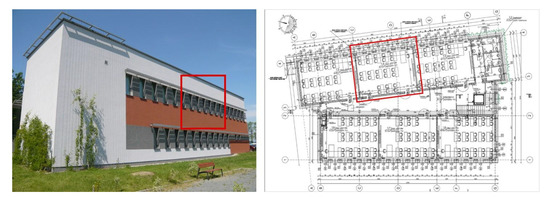
Figure 1.
Passive school in Budzów (author’s archive) and a floor plan [27] with the class under study marked.
2.2. The Criterion for Ensuring Thermal Comfort
The assessment of the microclimate consisted of measuring or calculating in a simulation program the basic values and derived physical parameters and then calculating the values of appropriate indicators so that they could be compared with the standard requirements [29]. For a temperate climate, the requirements and the methods regarding thermal sensation and dissatisfaction are set by the European Standard PN-EN ISO 7730: 2006 [30].
The instrument used to measure the thermal microclimate in the building analyzed was the integrated digital BABUC A meter (Figure 2), meeting the requirements of the PN-EN 7726 standard [31]. Sensors connected to the central unit measure dry and humid temperatures, thermal radiation, as well as the relative humidity of the air and air velocity.
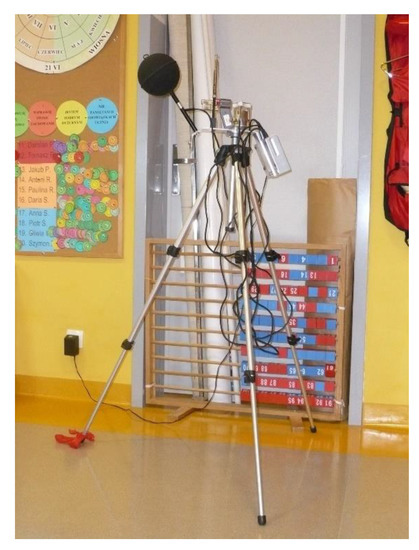
Figure 2.
BABUC A digital microclimate meter (author’s archive).
The basic indicators used to analyze thermal environmental conditions in a given room were predicted mean vote (PMV) and predicted percentage of dissatisfied (PPD), developed by Fanger [32]. The predicted mean vote is determined from the below empirical formula Equation (1) [30].
where:
PMV = [0.303 × exp(−0.306 × M) + 0.028] × ((M − W) − 3.05 × 10−3 × [5733 − 6.99 × (M − W) − pa]
−0.42 × [(M − W) − 58.15] − 1.7 × 10−5 × M × (5867 − pa) − 0.0014 × M × (34 − ta)
−3.96 × 10−8 × fcl × [(tcl + 273)4 − (t-r + 273)4] − fcl × hc × (tcl − ta))
tcl = 35.7 − 0.028 × (M − W) − Icl{3.96 × 10−8 × fcl × [(tcl + 273)4 − (t-r + 273)4] + fcl × hc × (tcl − ta)}
−0.42 × [(M − W) − 58.15] − 1.7 × 10−5 × M × (5867 − pa) − 0.0014 × M × (34 − ta)
−3.96 × 10−8 × fcl × [(tcl + 273)4 − (t-r + 273)4] − fcl × hc × (tcl − ta))
tcl = 35.7 − 0.028 × (M − W) − Icl{3.96 × 10−8 × fcl × [(tcl + 273)4 − (t-r + 273)4] + fcl × hc × (tcl − ta)}
M—metabolic intensity (W/m2)
W—energy flux density in the form of mechanical work (W/m2)
pa—partial water vapor pressure (Pa)
Icl—clothing insulation (m2K/W)
fcl—clothing surface area (m2)
ta—air temperature (°C)
t-r—mean radiant temperature (°C)
tcl—clothing surface temperature (°C)
hc—convective heat transfer coefficient (W/m2K)
The PPD index determines the percentage of people staying in a given environment and experiencing a lack of thermal comfort, and it is defined by the formula Equation (2):
PPD = 100 − 95e(0.03353PMV4+0.2179PMV2)
In thermal comfort conditions, for a class with medium requirements (category II according to EN 16798-1 [33]), the PMV value should be within the range of −0.5 to +0.5, which corresponds to 10% of PPD.
2.3. Simulation Model in Design Builder Program
A 3D model of the entire school in Budzów was created in the Design Builder (DB) program (Figure 3a,b). The parameters, structures, and installations of the facility, as well as schedules of people’s presence, were taken into account. The metabolic rate was selected as for “office work”. In the case of an adult male, this value was equal to 127 W/person. Due to the smaller body surface area of the students, the factor 0.85 was selected, as advised by the DB program. The metabolic energy of the student was assumed to be 108 W/person. This value, which is higher than usual in schools, results from the observation of children in lower classes and their increased movements. For the summer period analyzed, the Clo value introduced was equal to 0.5. The illuminance was set at 300 lux [34].
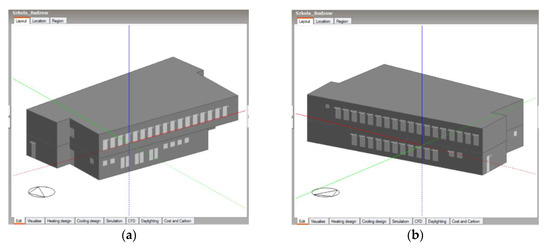
Figure 3.
(a) South-west elevation, (b) North-east elevation of a passive primary school building in Budzów generated in Design Builder.
Based on the design documentation and with the direct assistance of the HVAC system designer of the school, the Design Builder program defined detailed data of the mechanical ventilation system with individual settings for each zone.
The modeled system, according to the design, included boreholes (1), a heat pump (2), and air handling units (3) (Figure 4 and Figure 5). The Design Builder program assumed a constant airflow in the teachers’ room, headmaster’s room, and classrooms (constant air volume—CAV) (Figure 6). An individually regulated supply-exhaust system, implemented by variable air volume (VAV) regulators, was adopted in the dining room and in the backroom (Figure 6). The design for servicing the sanitary facilities included a separate small air handling unit. After consulting with the designer of the installation, in order to simplify the complicated system, the VAV option was also adopted in the modeling of sanitary facilities. This idea that was adopted for the solutions is similar to the actual functioning of the system.
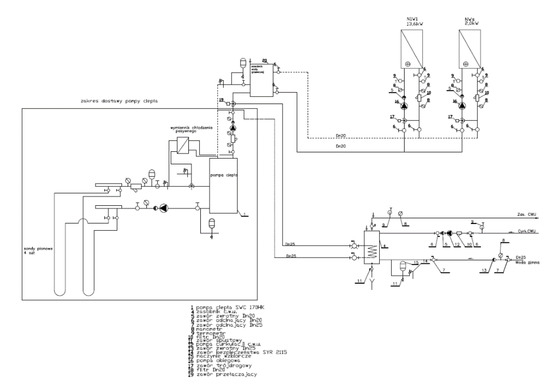
Figure 4.
Diagram of the boiler room according to the school’s installation project [35].

Figure 5.
Diagram of the HVAC system modeled in Design Builder.

Figure 6.
Diagram of the modeled constant air volume (CAV) system (left) and variable air volume (VAV) system (right).
The detailed design assumed that between 7.30 a.m. and 3 p.m., the ventilation operates continuously and at 100% of its maximum capacity. In the Design Builder program, the option that calculates the outdoor airflow rate based on the total number of people assigned to the zone was selected. The default value of the program was 20 cubic feet per minute (cfm), which corresponded to 0.00944 m3/s per person.
Automation of the air handling unit at the school enabled the system to operate in the so-called “free cooling” mode, in order to cool the rooms naturally with 100% cold outdoor air during periods when the object was not used (e.g., at night). The Design Builder program made it possible to include this form of free cooling when external conditions allowed it. In the modeled building, during the validation process, it was assumed that if the outdoor air temperature was higher than 24 °C and the building was not used, then the outdoor airflow rate was minimal (1 change per hour). Conforming to the design, at outdoor temperatures above 24 °C, when the facility was in use, the heat pump switched to the passive cooling mode, i.e., without the use of a compressor (water from the boreholes was directed through the exchanger to the cooler in the air handling unit, where the air was cooled and then distributed around the building). The model assumed, in line with the design premise, that the heat pump supplied water to the heat exchanger in the air handling unit at a temperature not lower than 17 °C. In keeping with the detailed design [27], 4 boreholes with a depth of 100 m were created during the modeling (Figure 7).
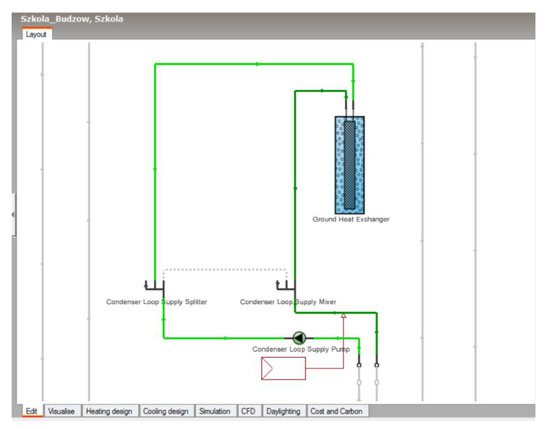
Figure 7.
Boreholes modeled in the Design Builder program.
It should be noted that, in keeping with the intended use, in the reference model variant (consistent with actual use) it was assumed that the windows were not opened during the operation of mechanical ventilation.
The simulation model was validated. The process of authenticating the model of the building, created in the Design Builder program, was difficult due to the complicated system of HVAC installations and the lack of complete detailed information about the operation of the installation during the research period. Although the entire school building was modeled, the validation concerned only one room in which the measurements were taken. However, the strenuous modifications carried out (about 80 trials), in consultation with the designer of the school’s installation in Budzów, made it possible to achieve a high level of consistency between the measurement data and simulation results.
While looking for the degree of correlation between the results obtained by means of measurements and simulations, the correlation coefficient was calculated. Comparing the results of measurements of indoor air temperature on 9–11 June 2014 with the results of the final model, the correlation coefficient value was 0.87 (Figure 8).
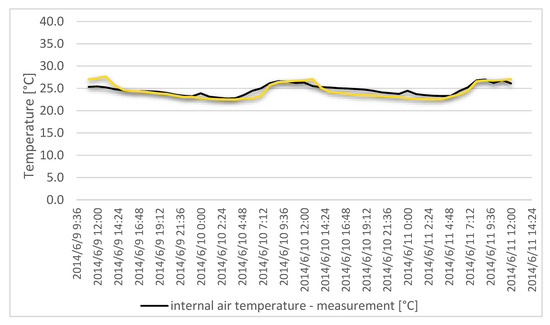
Figure 8.
Indoor air temperature distribution during the summer measurement in 2014 and the values obtained from the simulation model for the classroom studied.
The value of the correlation coefficient in the range of 0.7 ≤ r < 0.9 indicates a very high correlation in the statistical analysis [36]. Therefore, the model of the passive school in Budzów, made in the Design Builder program, can be used for further analyses. The value of the standard estimation error was equal to ±0.584 °C.
3. Results of Thermal Comfort Analysis
3.1. Experimental Analysis
Summer thermal comfort measurements were carried out twice in June 2013 (2 h) and in 2014 (3 days). Data were recorded each time at 5-min intervals. The average outdoor air temperature during the study in 2014 was 28 °C, while in June 2013 it was only 23 °C. The research period and the classroom with east-facing windows were chosen due to the sunlight and operational use of the school from 7.00 to 15.00. Due to the fact that the internal microclimate measurements were to be used mainly for model validation and detailed analyses in the simulation program, the indicative studies performed were a sufficient basis to confirm the existence of the problem.
In 2014, geothermal probes were used to cool the building, using the thermal capacity of the ground and working with a heat pump. In winter, the heat pump worked as an effective heating device with a Seasonal Coefficient of Performance SCOP > 4.5, drawing energy from the ground. In summer, due to the process reversal, the heating system became a source of cooling [37].
The values of thermal comfort indices as calculated are presented in Figure 9. In the case of measurements in 2013, the PMV results obtained were outside the thermal comfort zone (Figure 9). In turn, the average value of the PMV index in 2014, equal to −0.30, indicate comfortable conditions inside the classroom studied after the introduction of modifications to the functioning of the ventilation system. It was within the Fanger comfort range −0.5 < PMV > +0.5 required for category II buildings.
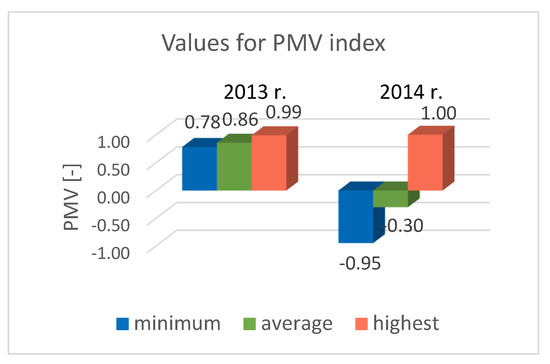
Figure 9.
Values of thermal comfort indicators as calculated.
Using the Design Builder simulation program, it was checked whether a properly operated mechanical ventilation system without ground probes or only natural ventilation would be able to reduce discomfort in summer as effectively as cooling from the ground.
3.2. Simulation Variants and Results
The mechanical ventilation system used in the school ensured forced air circulation and its exchange at the required level, regardless of the environmental conditions outside. As the measurements have shown, the mechanical ventilation system, additionally supported by a ground exchanger and a heat pump, effectively protected the users of the facility against the discomfort of summer. Due to the fact that the applied solution generated significant investment and operating costs, it was checked whether it would be possible to obtain thermal comfort in summer without cooling from the ground, depending on the type of ventilation. The simulations were carried out for a two-month period between 1 May–31 June. Due to the specific nature of the building, July and August were not taken into account, as the building is not used for its intended purpose during that period. Due to the distinct manner in which the facility is used, only the period of operation between 7.00 a.m. and 3 p.m. was subject to detailed analysis.
The required fresh airflow per student is 30 m3/h, so for 28 people, required air exchange at the level of 4 h−1 will satisfy the hygiene requirements of users of the classroom analyzed. The building design also assumes that fresh air exchange at a minimum level of 1 h−1 must be provided by mechanical ventilation when there are no users in the building.
Natural night cooling in simulations means opening windows (20% opening) in fixed hours from 11.00 p.m.–6.00 a.m.
Extremely varied values of the outdoor temperature in the spring and summer periods are the predominant feature of the temperate climate zone. In the two-month period analyzed, 50% of all hours had outdoor air temperatures below 15 °C (Table 1). In a period of only 15 h, the outdoor air temperature exceeded 30 °C. The temperature range of 25–30 °C encompasses 75 h, which corresponds to 5% of the entire period considered here.

Table 1.
The number of hours of outdoor air temperature in the given temperature ranges for the entire two-month analysis period.
The range of indoor air comfort temperature from 24 to 27 °C that was adopted for the analysis resulted from the established metabolic rate of children in the school studied, equal to 108 W/m2, and the clothing insulation level of 0.5, which is characteristic for the summer period. This assumption was confronted with the Design Builder PMV and PPD index calculator, which enabled the determination of the range of comfortable temperatures depending on environmental and individual parameters. For the adopted clothing insulation level of 0.5 clo, activity level of 108 W/person, and air velocity of 0.137 m/s, the PMV index at an indoor air temperature of 24 °C corresponded to the lower limit of thermal comfort, and at a temperature of 27 °C, it corresponded to the upper limit of thermal comfort.
The following variants of the simulation were adopted (Table 2):

Table 2.
Summary of assumptions for the simulation variants adopted.
- ▪
- Variant 1—Reference model. This building functions just as at the time of taking measurements; i.e., mechanical ventilation works with an efficiency of 100% (which in relation to the cubic capacity corresponds to approx. 4.5 h−1) when the facility is in use between 7.00 a.m.–3.00 p.m., and at night, from 11.00 p.m. to 6.00 a.m., the outdoor airflow is intensive (maximum ventilation capacity) to cool the building (free-cooling) when external conditions allow it, and at other times at least one air exchange per hour is carried out. This minimum outdoor airflow rate (1 h−1) applies when the outdoor air temperature is above 24 °C. Cooling is only passive—without the use of a heat pump, only the circulation pump is used; the water circulating in the ground exchanger is pumped to the heat recovery chiller, which cools the air distributed around the building;
- ▪
- Variant 2—Forced night ventilation (free-cooling). Maximum outdoor airflow (approx. 4.5 h−1) in the hours between 11.00 p.m. and 6.00 a.m. Mechanical ventilation kept on during the day from 7.00 a.m.–3.00 p.m.—at 4.5 h−1 regardless of external conditions, and at other times at 1 h−1. In this variant, no ground heat exchanger or natural ventilation were used;
- ▪
- Variant 3—Natural night cooling. Mechanical ventilation kept on during the day from 7.00 a.m. to 3.00 p.m.—approx. 4.5 h−1. At other times 1 h−1 was used, no ground exchanger was used, windows were kept closed during the day, natural night ventilation was used between 11.00 p.m. and 6.00 a.m. by way of a 20% tilt of all windows. The value of the minimum permissible indoor air temperature when tilting the windows is 20 °C;
- ▪
- Variant 4—Completely natural functioning of the building during the day and night. Mechanical ventilation turned off, no ground heat exchanger used, windows tilted during the day when the hall is in use, i.e., from 7.00 a.m. to 3 p.m. However, natural ventilation depends on external conditions (if Tout > Tint—windows are closed) and natural night ventilation between 11.00 p.m.–6.00 a.m. by the way of a 20% tilt of all windows. The value of the minimum permissible indoor air temperature when tilting the windows is 20 °C.
The efficiency of night ventilation was high only in the case of a high thermal inertia of the building structure. The significant reduction in temperature of the storage masses at night allowed them to accumulate large amounts of heat during the day. As it was shown earlier, a very massive building structure of the analyzed object had the required high storage capacity; therefore, this aspect was not selected as a subject to simulation variants.
The values of some environmental parameters as listed in Table 3 are the result of simulations. The maximum indoor air temperature in the analyzed room was calculated for the four simulation variants adopted, as well as the values of the operating temperature and radiation during the period of use of the object.

Table 3.
Values of indoor air temperature, operative temperature, and radiation temperature for a two-month period of analysis of the simulation variants adopted.
The highest values of indoor air temperature calculated in the two-month analysis period adopted were within the range of 27.7–31.6 °C. In the case of reference model variant 1, the highest internal air temperature was significantly reduced with the use of a ground heat exchanger, and amounted to 27.7 °C. For the other three models, the maximum indoor air temperature exceeded 31 °C. The difference in air temperature between the best variant 1 and the least favorable variant 3 was 3.9 K.
In the case of the highest operative temperature, similar values, of around 30.3–30.8 °C, could be observed in the three variants 2, 3, and 4. As before, a much lower value of 27.6 °C occurred in the case of passive cooling of a building using a ground heat exchanger (variant 1). The maximum ambient radiation temperature values were between 27.5 and 30.0 °C. Only in the variant with ground heat exchangers could the maximum radiation temperature value of 27.5 °C be observed, which was lower in comparison to the others. For variants 2, 3, and 4 (without passive cooling), these values oscillated around 30 °C.
Generally speaking, therefore, it should be stated that without mechanical cooling, all the variants of the operation of the building analyzed here gave significantly worse results than the reference model variant, and the differences among those variants were small.
Table 4 presents the results of the simulations carried out for the four variants, regarding the number of hours of thermal comfort and the degree-hours of overheating. The number of hours in the comfort temperature range for the two-month period of use and the number of hours beyond its upper limit value were calculated. Using the graphical distribution of the number of hours in individual ranges of indoor air temperature (Figure 10) available in the Design Builder program, the degree-hours of overheating of the room were calculated. They were defined as the time during which the temperature was outside the specified range when the object was in use, multiplied by the weighting factor. The weighting factor was the maximum temperature in a given range above the upper comfort limit. For the temperature range 27–28 °C, the weight was 1, for the temperature range 28–29 °C, it was 2, for the temperature range 29–30 °C, it was 3, for the temperature range 30–31 °C, it was 4, and for temperatures above 31 °C, the weighting factor was equal to 5 [33].

Table 4.
Number of hours of indoor air temperature within the thermal comfort range and outside this range for the two-month analysis period.
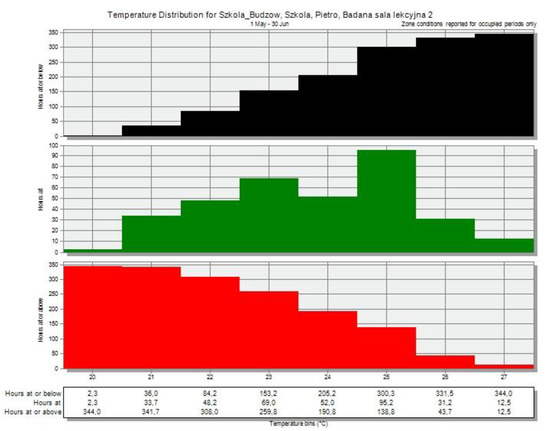
Figure 10.
Hourly distribution of indoor air temperature for the reference model variant (number of hours: In the comfort range—green, above the comfort range—red, below the comfort range—black).
Analyzing the number of hours with the air temperature in the comfort temperature range 24–27 °C, it can be observed, not surprisingly, that the highest number of hours were in variant 1 and amounted to 177 h. In the other cases, 2, 3, and 4 were clearly lower and practically equal values were obtained: 113, 114, and 116 h, respectively. The reference model variant, in which the heat pump was used, was also characterized by the lowest number of hours with temperatures above 27 °C: 13 h. In variants 2 and 3, where there was intensive mechanical ventilation during the day and there were no limitations against the inflow of warm air masses during hot days, the number of hours of discomfort was many times higher (44 h variant 2 and 47 h variant 3, respectively). However, the worst result was obtained in the case of variant 4: 65 h. The degree-hours of discomfort are presented in Figure 11.
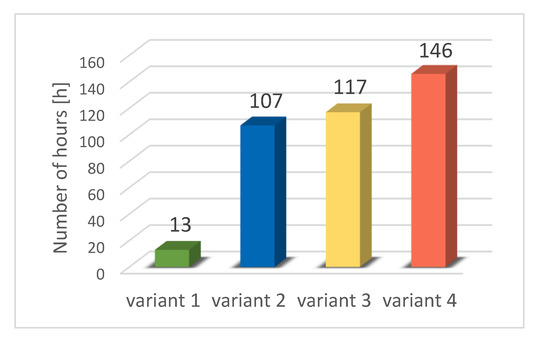
Figure 11.
Degree-hours of discomfort for the four simulation variants.
Table 5 presents the values of the PMV index calculated for the four simulation variants. Passive cooling with the use of a ground exchanger and a heat pump was by far the most effective solution in ensuring thermal balance of the body. In the case of the reference model variant, the number of hours in the comfort range was the highest and amounted to 165 h, out of 344 h that constituted the entire period analyzed. Variants 2 and 3, characterized by forced daytime ventilation, but with different forms of night cooling, had almost the same number of hours in the comfort range of 110 and 112 h, respectively. Although variant 4 had more hours in the −0.5 < PMV < +0.5 range than variants 2 and 3, it was the completely natural method of ventilation that generated the most hours of discomfort in summer.

Table 5.
Hourly distribution of the predicted mean vote (PMV) index for the adopted simulation variants.
4. Aggregated Overheating Measure
When defining the assessment of general conditions of thermal comfort, as an example, the percentage of hours outside the ranges PMV or temperature was given, or alternatively, it used the criterion of degree-hours or weighted PPD values [30]. In order to objectively assess the comfort conditions, the author proposed a slightly different, very simple method of measuring discomfort related to overheating. The time during which the PMV value exceeded the specified range while the facility was in use was multiplied by the suitable weighting factor appropriate to the extent to which the range had been exceeded. In this way, not only the duration of the discomfort, but also its intensity could be included in a single-valued attribute. Initially, in the doctoral dissertation [38], a linear scale of assessment was proposed, but was modified due to rapidly increasing negative thermal sensations at high PMV values. The detailed algorithm for this calculation is as follows:
- 1..
- The weighting factor kc equals 0 when PMV is within the recommended thermal comfort range: −0.5 < PMV < +0.5;
- 2.
- The weighting factor kc is taken in accordance with Table 6, depending on how much the maximum comfort range is exceeded by;
 Table 6. Method of calculating the weighting factor for measuring overheating discomfort.
Table 6. Method of calculating the weighting factor for measuring overheating discomfort.
- 3.
- The products of the weighting factor kc and the number of hours for all ranges are summed up. For the sake of simplicity, it is assumed that the conventional unit of measurement is PMV-hour (PMVh).
The weighted measures of discomfort for the adopted variants were estimated as follows:
Variant 1: (9 · 1.0) + (0 · 2.0) + (0 · 4.0) = 9.0 PMVh
Variant 2: (15 · 1.0) + (15 · 2.0) + (2 · 4.0) = 53.0 PMVh
Variant 3: (16 · 1.0) + (18 · 2.0) + (4 · 4.0) = 68.0 PMVh
Variant 4: (22 · 1.0) + (15 · 2.0) + (11 · 4.0) = 96.0 PMVh
Variant 2: (15 · 1.0) + (15 · 2.0) + (2 · 4.0) = 53.0 PMVh
Variant 3: (16 · 1.0) + (18 · 2.0) + (4 · 4.0) = 68.0 PMVh
Variant 4: (22 · 1.0) + (15 · 2.0) + (11 · 4.0) = 96.0 PMVh
The weighted measures of discomfort related to overheating calculated for the four simulation variants are shown in Figure 12. Taking into account the use of a ground heat exchanger, the reference model variant was significantly better than the other models in terms of discomfort.
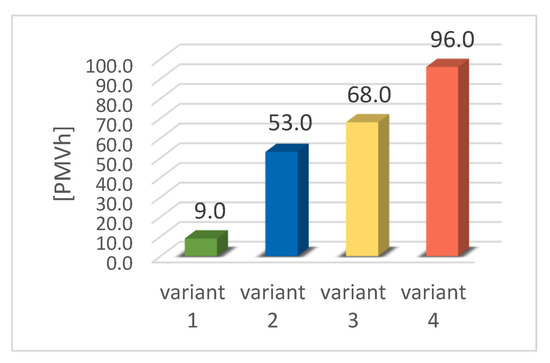
Figure 12.
Weighted measure of discomfort related to overheating.
The tallest bar representing discomfort in Figure 12 (red) applied to the model that adopted the completely natural ventilation of the building. It is well-known that the thermal component of the natural air exchange mechanism works most effectively on colder days. The difference in air temperature between the building and the environment causes a difference in density and pressure, which in turn translates into air circulation by natural convection. The pressure difference, and thus the intensity of ventilation is proportional to the difference between indoor and outdoor air temperatures. Due to the fact that the period analyzed is of high outdoor temperatures, natural ventilation is not able to provide the desired air exchange. Figure 13 shows the distribution of the outdoor air temperature for the four hot days selected and a graph of the intensity of natural ventilation exchange in variant 4. The intensity of air exchange at night at 2.9–4.0 h−1 (Figure 13) was not sufficient to remove the excessive heat gains stored during the day and to adequately cool the well-insulated body of the building.
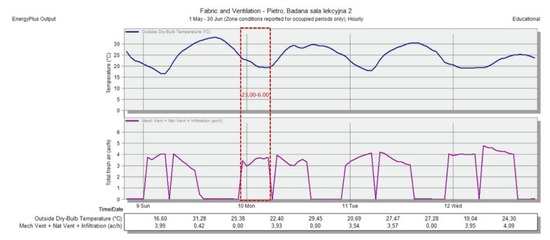
Figure 13.
Distribution of outdoor air temperature and intensity of air exchange in natural ventilation (variant 4) for the selected four days, generated in Design Builder program.
The second case (the blue bar in Figure 12), adopting the same method of supply and exhaust ventilation during the day as in the third variant, but with mechanical exchange at night as well, resulted in fewer hours of overheating-related discomfort. Working at night with a constant, controlled intensity at the level of 4.5 h−1, the mechanical ventilation more effectively removed the accumulated excess energy. In the third option (yellow in Figure 12), the natural night ventilation was less intense (2.9–4.0 h−1) compared to the second option, which resulted in a lower pressure difference between indoor and outdoor conditions during warm nights.
5. Discussion of Results
As expected, it can therefore be concluded that the mechanical ventilation system in combination with a cooling source in the form of a ground heat exchanger and heat pump effectively reduced discomfort in summer. However, it is also worth taking a slightly different look at the building, its equipment, and the method of assessing the thermal conditions inside it. In the guidelines laid down by the Passive House Institute in Darmstadt for the design of passive buildings [39], the period of overheating the interior lasting up to 10% of the year is permissible. Considering only the two-month period analyzed, it could be observed that the number of hours of discomfort for the individual variants was approximately 3%, 9%, 11%, and 14%, respectively, of this period of using the building. According to this criterion, variant number 2, adopting the use of only mechanical ventilation, but without the use of a ground heat exchanger, met the permissible requirements of the German institute. The main difference between variants 3 and 4 and the reference variant related to 29 and 39 h of additional interior overheating. It constituted approx. 8% and 11% of the analyzed two-month use of the building. Other guidelines in Building Bulletin BB87 [40] for designing appropriate environmental conditions in schools included permissible overheating criteria of 80 operating hours at a temperature of ≥28 °C per year. In the context of such an approach, all three ways of ventilating the building, without ground cooling, would be sufficient to ensure adequate working conditions.
It should be added that in buildings with natural ventilation, as was adopted in variants 3 and 4, it is suggested to take into account the adaptation of users to environmental parameters [41,42]. The adaptive method of determining thermal comfort is applicable to rooms without mechanical cooling, where the metabolic heat of users falls within the range of 1.0–1.3 met. In this model, users were expected to dress appropriately for the outdoor temperatures in the range of 0.5–1.0 clo. The adaptive model has been used in ASHRAE [43] as well as in the PN-EN 15251 standard [44], which is a translation of the English version EN 15251:2007. In 2019, the European standard was updated to PN-EN 16798-1:2019-06 [33]. In each of these standards, the comfort temperature and operating temperature limits have been set for individual building categories. There are two ranges of indoor operative temperatures, which are considered comfortable for 80% and 90% of users, respectively, at different outdoor air temperature values.
Although mechanical ventilation was used in the school analyzed in Budzów, in the real use of the building, windows were opened. In modeling the building, a low insulation value of clothing, clo equal to 0.5, was adopted. During the research, it was found that students and teachers easily adjusted their clothes to the prevailing conditions. Conforming to Annex G of the hitherto binding standard, PN-EN 15251 [44], pursuant to 5% deviations from the thermal comfort range, 9 h of discomfort were allowed per month (2 h a week, 108 h a year). On the other hand, according to the new standard PN-EN 16798-1: 2019-06 (and Technical Report prCEN/TR 16798-2 [45]), the acceptable range of discomfort may be up to 6% per year (i.e., 126 h), but at the same time no more than 20 h in a working week and no more than 44 h in a working month. Following the approach contained in PN-EN 16798-1: 2019-06, the results obtained for all variants were within the tolerance limits and constituted, respectively, 10%, 36%, 43%, and 54% of the maximum allowed value for a two-month period. Therefore, taking into account the adaptation of users and the way the building is used, a milder assessment of the microclimate may have allowed, after meeting the requirements, for the acceptance of conditions considered as overheating according to the Fanger criterion. However, while accepting this overheating, the possible deterioration of the students’ concentration, fitness, and reflexes should be taken into account.
In recent years, there has been an increase in interest in heat pumps and ground exchangers; however, large investment costs are still a barrier to their widespread use. As can be seen from the simulations carried out, the mentioned installations favorably shaped the thermal comfort in summer, but the operation of the heat pump was also associated with considerable input of electricity, and due to the high conversion factor, it significantly increased the demand for primary energy. Another aspect was the environmental and ecological assessment of buildings and their installations, as well as contemporary trends for the simplest possible solutions in the building industry while maintaining the principles of sustainable development. Due to the aforementioned economic and ecological considerations, investors often backed off from expensive installations, while accepting the increased risk of overheating the interior. The abovementioned parallel assessment of the conditions in the schoolroom analyzed confirmed significant differences between the various approaches. The application of the adaptive approach to the assessment of thermal conditions and the acceptance of limited overheating periods led to the conclusion that the building analyzed could function successfully without these additional installation elements.
6. Conclusions
The use of an advanced installation with a heat pump and ground heat exchanger is associated with significant additional investment costs, operating costs, and consequently a burden on the environment. Therefore, in this paper the authors looked for the alternative possibilities and methods for maintaining indoor thermal comfort conditions.
The simulations carried out regarding the thermal comfort in a school building during the summer period allowed for the following conclusions:
- ▪
- Intensive night mechanical ventilation combined with high thermal inertia of building structure, without a ground heat exchanger or heat pump, allows for a significant reduction of thermal discomfort in the interior analyzed. However, it is not possible to completely protect the building from overheating in this way in the hottest period of the year and to meet the requirements of the Fanger model at the same time;
- ▪
- However, in line with current trends as well as standard requirements, the assessment of the indoor climate in buildings without mechanical cooling takes into account the natural adaptation of the user’s body to the conditions of elevated ambient temperature. The conditions in the schoolroom analyzed fully met the adaptive comfort criteria included in the PN-EN 16798-1: 2019-06 standard;
- ▪
- The analyses carried out in this article confirmed the possibility of giving up the mechanical cooling system of the building using a hybrid system of mechanical and natural ventilation;
- ▪
- A ventilation system that is mechanically simple, however, requires an intelligent control system, which takes into account the prevailing hygienic requirements and at the same time minimizes heat gains from the outdoor air in the hot season, cool down the thermal mass of the building at night, but prevent its excessive cooling, etc.;
- ▪
- An adaptive method of determining thermal comfort should be used wherever possible. The synergy of the internal environment, controlled by users in response to the prevailing external conditions and low energy consumption in passive buildings, is an indispensable component of the idea of sustainable development. Taking into account the possibilities of human thermoregulation and active control of conditions by users through opening windows, using shading devices or controlled air exchange, it is possible to design buildings that guarantee good thermal conditions with minimal investment and operating costs and limited environmental impact.
As a continuation of the overheating problem raised, analyses of the influence of thermal mass on microclimate parameters and the influence of the comfort model on the assessment of conditions in an overheated passive building are planned. In subsequent articles, it is also planned to analyze the impact of various structural and material solutions (thermally activated ceilings, phase change materials) on limiting discomfort in summer.
Author Contributions
Conceptualization, A.D., T.K.; methodology, A.D., T.K.; software, A.D.; validation, A.D.; writing—review and editing, A.D., T.K. All authors have read and agreed to the published version of the manuscript.
Funding
This research was funded by the grant L-1/337/2014/DS-M from the Faculty of Civil Engineering, Cracow University of Technology.
Data Availability Statement
The data presented in this study are available on request from the corresponding author.
Conflicts of Interest
The authors declare no conflict of interest.
References and Notes
- Dudzińska, A. Effectiveness of sunshades in shaping thermal comfort in a passive public building. J. Civ. Eng. Environ. Arch. 2015, XXXII, 39–48. [Google Scholar] [CrossRef]
- Jones, R.J.; Goodhew, S.; De Wilde, P. Measured Indoor Temperatures, Thermal Comfort and Overheating Risk: Post-occupancy Evaluation of Low Energy Houses in the UK. Energy Procedia 2016, 88, 714–720. [Google Scholar] [CrossRef]
- Pomfret, L.; Hashemi, A. Thermal Comfort in Zero Energy Buildings. Energy Procedia 2017, 134, 825–834. [Google Scholar] [CrossRef][Green Version]
- Kisilewicz, T. Passive control of indoor climate conditions in low energy buildings. Energy Procedia 2015, 78, 49–54. [Google Scholar] [CrossRef][Green Version]
- Bzowska, D. Risk of Overheating of Heat Insulated Buildings in the Summer Time. J. Civ. Eng. Environ. Arch. 2016, XXXIII, 43–52. [Google Scholar] [CrossRef][Green Version]
- Bzowska, D. Changes in temperature in buildings in response to the changing climate. Tech. Trans. 2012, 3, 37–44. [Google Scholar]
- Fedorczak-Cisak, M.; Furtak, M.; Gintowt, J.; Kowalska-Koczwara, A.; Pachla, F.; Stypuła, K.; Tatara, T. Thermal and Vibration Comfort Analysis of a Nearly Zero-Energy Building in Poland. Sustainability 2018, 10, 3774. [Google Scholar] [CrossRef]
- Breesch, H.; Janssens, A. Reliable design of natural night ventilation using building simulation. In Proceedings of the 10th Thermal Performance of the Exterior Envelopes of Whole Buildings Conference: 30 Years of Reearch, Clearwater Beach, FL, USA, 2–7 December 2007; ASHARE: Atlanta, GA, USA, 2007. [Google Scholar]
- Kolokotroni, M.; Aronis, A. Cooling-energy reduction in air-conditioned offices by using night ventilation. Appl. Energy 1999, 63, 241–253. [Google Scholar] [CrossRef]
- Kolokotroni, M.; Webb, B.C.; Hayes, S.D. Summer cooling with night ventilation for office buildings in moderate climates. Energy Build. 1998, 27, 231–237. [Google Scholar] [CrossRef]
- Pfafferott, J.U.; Herkel, S.; Wambsganß, M. Design, monitoring and evaluation of a low energy office building with passive cooling by night ventilation. Energy Build. 2004, 36, 455–465. [Google Scholar] [CrossRef]
- Pfafferott, J.U.; Herkel, S.; Jäschke, M. Design of passive cooling by night ventilation: Evaluation of a parametric model and building simulation with measurements. Energy Build. 2003, 35, 1129–1143. [Google Scholar] [CrossRef]
- Firth, S.; Cook, M. Natural Ventilation in UK Schools: Design for Passive Cooling, Proceedings of Conference: Adapting to Change: New Thinking on Comfort: London, 2010, Network for Comfort and Energy Use in Buildings. Available online: http://nceub.org.uk (accessed on 24 December 2020).
- Tymkow, P.; Tassou, S.; Kolokotroni, M.; Jouhara, H. Building Services Design for Energy Efficient Buildings, Built Environment, Engineering & Technology; Routledge: London, UK, 2013. [Google Scholar] [CrossRef]
- Givoni, B. Effectiveness of mass and night ventilation in lowering the indoor daytime temperatures, Part I: 1993 experimental periods. Energy Build. 1998, 28, 25–32. [Google Scholar] [CrossRef]
- Kolokotroni, M. Night ventilation, cooling of office building: Parametric analyses of conceptual energy impacts. ASHRAE Trans. 2001, 107, 479–489. [Google Scholar]
- Gratia, E.; Bruyere, I.; De Herde, A. How to use natural ventilation to cool narrow office buildings. Energy Build. 2004, 39, 1157–1170. [Google Scholar] [CrossRef]
- Blondeau, P.; Spérandio, M.; Allard, F. Night ventilation for building cooling in summer. Sol. Energy 1997, 61, 327–335. [Google Scholar] [CrossRef]
- Breesch, H.; Bossaer, A.; Janssens, A. Passive cooling in a low-energy office building. Sol. Energy 2005, 79, 682–696. [Google Scholar] [CrossRef]
- Artmann, N.; Manz, H.; Heiselberg, P. Climatic potential for passive cooling of buildings by night-time ventilation in Europe. Appl. Energy 2007, 84, 187–201. [Google Scholar] [CrossRef]
- Artmann, N.; Manz, H.; Heiselberg, P. Parameter study on performance of building cooling by night-time ventilation. Renew. Energy 2008, 33, 2589–2598. [Google Scholar] [CrossRef]
- Kolokotroni, M. Night ventilation in commercial buildings. In Review of Low Energy Cooling Technologies, International Energy Agency, Energy Conservation in Buildings and Community Systems Programme, Annex 28 Low Energy Cooling, Subtask 1 Report; British Crown Copyright: London, UK, 1995; pp. 7–11. [Google Scholar]
- Lechner, N. Heating, Cooling, Lighting: Design Methods for Architects; John Wiley and Sons: New York, NY, USA, 2001; pp. 245–278. [Google Scholar]
- Santamouris, M.; Asimakopoulos, D. Passive Cooling of Buildings; James and James: London, UK, 1996. [Google Scholar]
- Geros, V.; Santamouris, M.; Papanikolaou, N.; Guarraccino, G. Night ventilation in urban environments. In Proceedings of the AIVC Conference, Bath, UK, 11–14 September 2001. [Google Scholar]
- Santamouris, M. Passive Cooling of Buildings, Advances of Solar Energy, ISES; James and James Science Publishers: London, UK, 2005. [Google Scholar]
- Detailed design of the communal elementary school in Budzów—Architecture, architect Bożena Bończa-Tomaszewska from the architectural studio Bończa-Studioarch.
- Polish Committee for Standardization. PN-EN 13829:2002, Thermal Performance of Buildings—Determination of Air Permeability of Buildings—Fan Pressurization Method; Polish Committee for Standardization: Warsaw, Poland, 2002. [Google Scholar]
- Dudzińska, A.; Kotowicz, A. Features of materials versus thermal comfort in a passive building. Procedia Eng. 2015, 108, 108–115. [Google Scholar] [CrossRef]
- Polish Committee for Standardization. PN-EN ISO 7730:2006, Ergonomics of the Thermal Environment—Analytical Determination and Interpretation of Thermal Comfort Using Calculation of the PMV and PPD Indices and Local Thermal Comfort Criteria; Polish Committee for Standardization: Warsaw, Poland, 2013. [Google Scholar]
- Polish Committee for Standardization. PN-EN ISO 7726: 2001, Ergonomics of the Thermal Environment-Instruments for Measuring Physical Quantities; Polish Committee for Standardization: Warsaw, Poland, 2013. [Google Scholar]
- Fanger, P.O. Thermal Comfort; Arkady: Warsaw, Poland, 1974. [Google Scholar]
- European Committee for Standardization. EN 16798-1:2019-06, Indoor Environmental Input Parameters for Design and Assessment of Energy Performance of Buildings Addressing Indoor Air Quality, Thermal Environment, Lighting and Acoustics; European Committee for Standardization: Brussels, Belgium, 2019. [Google Scholar]
- European Committee for Standardization. EN 12464-1:2011, Light and Lighting—Lighting of Work Places—Part 1: Indoor Work Places; European Committee for Standardization: Brussels, Belgium, 2011. [Google Scholar]
- Detailed design of the communal elementary school in Budzów Water and sewage installations central heating, hot water, mechanical ventilation and air conditioning, architect Bożena Bończa-Tomaszewska from the architectural studio Bończa-Studioarch.
- Jóźwiak, J.; Podgórski, J. Statistics from Scratch; PWE: Warszawa, Poland, 2009. [Google Scholar]
- Firląg, S. Co-Participation of Mechanical Ventilation with GHE in a Passive Building; Rynek Instalacyjny: Warsaw, Poland, 2007. [Google Scholar]
- Dudzińska, A. Ways of Shaping and Exploitation of Passive Public Utility Buildings Taking into Consideration the Requirements for Thermal Comfort. Ph.D. Thesis, Cracow University of Technology, Krakow, Poland, 2019. [Google Scholar]
- Figielek, A.; Królczyk, B. Passive Buildings; WIDP Wielkopolski Dom Pasywny: Poznań, Poland, 2015. [Google Scholar]
- NBS. Building Bulletin 87, Guidelines for Environmental Design in Schools, Department for Education and Skills, 2nd ed.; The Stationery Office Ltd: London, UK, 2003. [Google Scholar]
- Kaczmarczyk, J. Methods of Investigation and Evaluation of Thermal Environment Indoors; Politechnika Śląska: Gliwice, Poland, 2008. [Google Scholar]
- Pfafferott, J.U.; Herkel, S.; Kalz, D.E.; Zeuschner, A. Comparison of low-energy office buildings in summer using different thermal comfort criteria. Energy Build. 2007, 39, 750–757. [Google Scholar] [CrossRef]
- ASHRAE. ANSI/ASHRAE Standard 55-2013 Thermal Environmental Conditions for Human Occupancy; ASHRAE: Atlanta, GA, USA, 2017. [Google Scholar]
- Polish Committee for Standardization. PN-EN 16798-1:2019-06, Indoor Environmental Input Parameters for Design and Assessment of Energy Performance of Buildings Addressing Indoor Air Quality, Thermal Environment, Lighting and Acoustics; Polish Committee for Standardization: Warsaw, Poland, 2006. [Google Scholar]
- Polish Committee for Standardization. prCEN/TR 16798-2, Guideline for Using Indoor Environmental Input Parameters for the Design and Assessment of Energy Performance of Buildings; Polish Committee for Standardization: Warsaw, Poland, 2019. [Google Scholar]
Publisher’s Note: MDPI stays neutral with regard to jurisdictional claims in published maps and institutional affiliations. |
© 2020 by the authors. Licensee MDPI, Basel, Switzerland. This article is an open access article distributed under the terms and conditions of the Creative Commons Attribution (CC BY) license (http://creativecommons.org/licenses/by/4.0/).